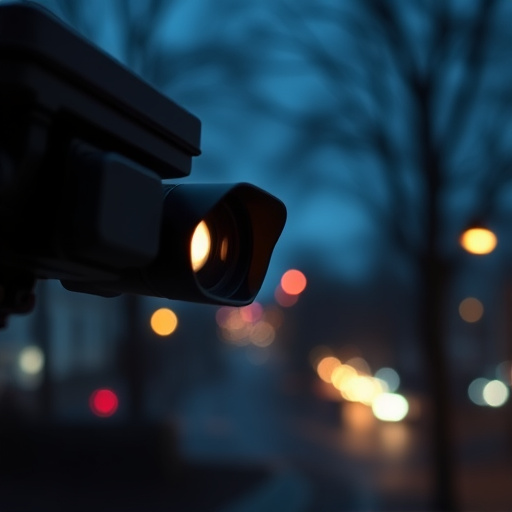Battery-powered spy cameras designed for outdoor use have gained popularity due to their convenience, extended battery life, and weather resistance, making them ideal for security, wildlife observation, and remote surveillance. However, nighttime glint detection remains a challenge, requiring advanced algorithms, image processing techniques, lens design, and sensing capabilities that balance low-light performance with minimal false positives. Innovative models are transforming night-time surveillance with discreet, flexible designs and high-quality low-light footage, revolutionizing security methods through enhanced outdoor glint detection.
In the age of surveillance, battery-powered spy cameras have become ubiquitous, particularly in outdoor settings. However, their effectiveness is often hindered by the challenge of night-time glint detection—the reflection of light from lenses that can obscure crucial visuals. This article offers a comprehensive overview of understanding and overcoming this hurdle. We explore innovative approaches tailored to outdoor environments, delving into practical implementation and testing procedures to ensure optimal glint detection for battery-powered spy cameras.
- Understanding Battery-Powered Spy Cameras: A Comprehensive Overview
- The Challenge of Nighttime Glint Detection
- Innovative Approaches to Outdoor Glint Detection Using Battery-Powered Spy Cameras
- Practical Implementation and Testing Procedures for Effective Glint Detection
Understanding Battery-Powered Spy Cameras: A Comprehensive Overview
Battery-powered spy cameras, designed for outdoor use, have become increasingly popular due to their convenience and covert operation capabilities. These devices are typically equipped with long-lasting batteries that enable them to operate autonomously over extended periods, making them ideal for surveillance in remote or hard-to-reach areas. The ‘outdoor’ application requires these cameras to withstand varying weather conditions, from intense sunlight to heavy rainfall, ensuring their durability and reliability.
Understanding the power source is crucial when considering a battery-powered spy camera. Rechargeable batteries are commonly used, offering eco-friendly and cost-effective solutions. Advanced models may incorporate solar panels or motion-activated charging mechanisms, further extending their operational time. This autonomy allows for continuous monitoring without the need for frequent manual intervention, making them perfect for security, wildlife observation, or remote surveillance applications.
The Challenge of Nighttime Glint Detection
Nighttime glint detection in outdoor settings presents a unique challenge, especially for battery-powered spy cameras designed for discreet surveillance. The low light conditions and potential reflections from surrounding surfaces can make it difficult for these cameras to capture clear images or videos. Glints, caused by light reflecting off smooth surfaces like water, glass, or even the moon, can obscure details and reduce the overall quality of footage. This issue is further exacerbated by the fact that outdoor environments are often dynamic, with moving objects and varying lighting levels, making real-time glint detection a complex task.
The challenge lies in developing algorithms and techniques that can accurately identify and mitigate glints without compromising the camera’s low-light performance. Researchers and engineers must consider factors such as image processing, lens design, and advanced sensing capabilities to tackle this problem effectively. By employing innovative methods, battery-powered spy cameras can enhance their nighttime surveillance abilities, ensuring clearer and more reliable visual data collection under challenging conditions.
Innovative Approaches to Outdoor Glint Detection Using Battery-Powered Spy Cameras
Innovative technologies are transforming night-time surveillance with an emphasis on enhancing outdoor glint detection. One such advancement involves the strategic deployment of battery-powered spy cameras, offering a discreet and flexible solution. These compact devices, often equipped with advanced sensors and low-light capabilities, can be strategically positioned in various outdoor environments to capture clear images and videos even under minimal light conditions.
The use of battery-powered spy cameras enables continuous monitoring without the hassle of complex wiring or power connections. This freedom allows for more dynamic and effective glint detection, as these cameras can be easily moved or concealed, providing a comprehensive view of hard-to-reach areas. With their ability to capture high-quality footage in low-light scenarios, these innovative devices are revolutionizing outdoor security and surveillance methods.
Practical Implementation and Testing Procedures for Effective Glint Detection
Practical Implementation and Testing Procedures for Effective Glint Detection
The practical implementation of glint detection in battery-powered spy cameras designed for outdoor use involves several key steps. First, the camera needs to be equipped with advanced sensors capable of capturing low-light images and videos accurately. These sensors should have a high dynamic range to mitigate over- or under-exposure, which can cause glints to go unnoticed. Next, specialized algorithms must be employed to analyze each frame for reflective surfaces, such as glass windows, smooth metal, or water bodies, that could produce glints. Real-time processing is essential to ensure immediate detection and response, especially in dynamic outdoor environments.
Testing procedures should focus on validating the camera’s performance under diverse lighting conditions, including low light and direct sunlight, to ensure accurate glint identification. Simulated tests using reflective surfaces can help refine the algorithm’s sensitivity and reduce false positives. Field trials in various outdoor settings—urban, suburban, and rural—are crucial to gather real-world data on the camera’s effectiveness against different environmental factors like foliage, snow, and varying weather conditions. Continuous monitoring and iterative improvements based on feedback loops will optimize the glint detection capability of battery-powered spy cameras for outdoor surveillance applications.
The detection of glints from battery-powered spy cameras in outdoor environments presents a complex challenge. However, with innovative techniques and careful implementation, it is achievable. By combining advanced algorithms, high-sensitivity sensors, and strategic placement, these methods significantly enhance security measures. Effective glint detection not only improves surveillance capabilities but also ensures the privacy and safety of individuals in various settings. As technology advances, continuous research and development will further refine these techniques, making them indispensable tools for outdoor surveillance.
